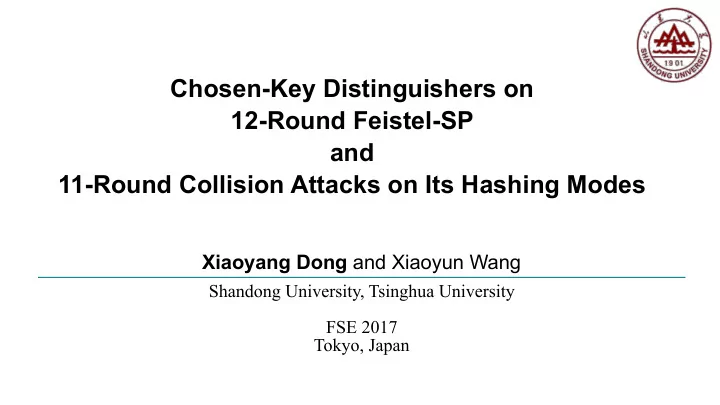

Chosen-Key Distinguishers on 12-Round Feistel-SP and 11-Round Collision Attacks on Its Hashing Modes Xiaoyang Dong and Xiaoyun Wang Shandong University, Tsinghua University FSE 2017 Tokyo, Japan
Outline 2
Secret-key and Open-key Models u Secret-key model the key is random and secret ü the attacker tries to recovery the key or distinguish from random ü permutation u Open-key model known-key, the key is known to the attacker, proposed by Knudsen ü and Rijmen in ASIACRYPT 2007 chosen-key, the key is under the control of the attacker ü the attacker tries to exhibit some non-ideal property of the primitive ü 3
Previous works of chosen-key attacks u Biryukov et al [CRYPTO 2009] Full AES-256 u Lamberger et al [ASIACRYPT 2009] Full Whirlpool CP func u Gilbert and Peyrin [FSE 2010] AES-like permutations u PA Fouque et al [CRYPTO 2013] 9-r AES-128 u Nikolić et al [ICISC 2010] Feistel and SPN u Minier et al. [FSE 2011] Generalized Feistel u Sasaki and Yasuda [FSE 2011] Feistel-SP and MMO MP u Sasaki et al [ACISP 2012] Camellia u Sasaki et al [INDOCRYPT 2012] Double SP-functions Known-key attacks 4
Our attacks u Knudsen and Rijmen (ASIACRYPT 2007) Arbitrary Round Function 7-round Feistel Known-key Distinguisher Ø ü 7-round half-collision on hashing modes ü u Sasaki and Yasuda (FSE 2011) 11-round Feistel Known-key Distinguisher ü SP Round Function Ø 9-round full-collision on hashing modes ü u Our works 12-round Feistel Chosen-key Distinguisher ü 11-round full-collision on hashing modes ü 5
Classification of Feistels by Round Function u Isobe and Shibutani [AC 2013] divide Feistels into three types u Feistel-3 is also called Feistel-SP 6
Feistel-SP Round Functions Permutation is assumed to be MDS: Maximum distance separable 7
Known-key and Chosen-key Distinguisher (P(1), F) (P(1), F) Randomly Some Special Cipher Cipher Key Key (P(1), F) (1, P(1)) Sasaki and Yasuda's Known-key Our Chosen-key Distinguisher Distinguisher Common: find such a pair for the Feistel network faster than we do for a random permutation 8
Basic Technique: Rebound Attack u Rebound attack, proposed by Mendel et al. u Find pairs meet certain truncated differential Inbound phase: a MITM phase that generate pairs meet the truncated u differential in E in in low time Outbound phase: pairs generated in Inbound propagate forward and u backward to match the full path E bw E in E fw u First of all, find a proper path inbound outbound outbound 8
Sasaki and Yasuda’s work 3 R Outbound Phase 5 R Inbound Phase 3 R Outbound Phase 5r Inbound 11r Known-key Distinguisher 10
Our works Find a 7r Inbound 5r Inbound 11
Our work Only γ is unknwon u The equation makes 7r inbound phase right u One must find γ to make it right if we find it by traversing it, it costs 2 64 u u Our Idea: suppose the underlined are equal, γ is find immediately u In fact, we only choose key to make the underlined equal partially, i.e. Thus we tranverse only 2 bytes to get γ, cost 2 16 u 12
Our works 3r Outbound phase 2r Outbound phase Ø We get a 12r Chosen-key Distinguisher 13
u Application to Hashing Modes 8
Merkle–Damgård Hash 15
Hashing modes (PGV modes) l apply to MMO-mode and Miyaguchi-Preneel modes l keys are the chaining value or IV 16
Collision: Compression Function M Some Cipher Special Key C 11r Feistel-SP Cipher 17
Collision: Hash Function u Translate the collision of Compression Function to Hash u Using two blocks to generate collision in H2 u Rebound attack is in the 2nd block u Prepare all (H 1 ,M 1 ,M 1 '), H 1 as key, that meet the truncated differential u Randomly pick M 0 , compute H 1 , check H 1 18
计算 7 轮 inbound 的起点 19
20
Experiment u We replace the linear permutation of Camellia by block cipher Khazad' MDS [BR00], called Camellia-MDS in following, to give an experiment 21
Find a pair has the following differential P1 = (1f 17 7f 72 7a f5 37 53, 5f f4 d9 23 59 e0 e6 75) P2 = (8a b5 11 89 23 29 49 9f, a1 9e 90 58 02 e8 fa 25) key = (69 e4 4a 60 1e ea 50 20, 0a 3b 81 ae ad 3a 79 bc) 22
23
Thank you
Recommend
More recommend